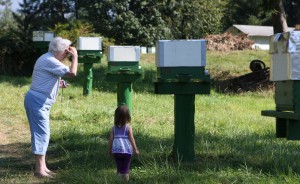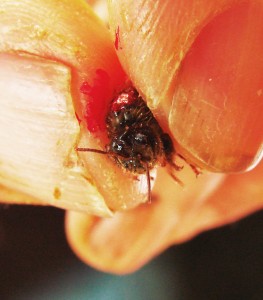
Welcome to Northwest Queens website! Our Apiaries are located in Arlington, Washington right in the heart of the Pacific Northwest. Our honey flow season is short and it takes just the right bees to do well here. Many beekeepers are just now realizing just how important it is to have bees that are adapted to their particular region. Southern bees just don’t do as well in northern climates as local bees do.
Since 2000, Northwest Queens has been dedicated to developing mite resistant honey bees suited for the Northwest climate. As I begin to write about this years work and preparations for 2019 I can’t emphasize enough how challenging this task has been. This task is being made worse by the group who continue to treat their hives. They have created a mite that can no longer be considered a parasite because parasites don’t kill their hosts. This management by treatment method has been successful in producing super mites that will drive a hive to their death. And even more important to my work is all the drones these treated colonies produce have no mite resistance and pollute the mating landscape making natural mating next to impossible. Thankfully instrumental insemination is available. I watched over the last twenty years the mite resistance improvements using the, “treat as you go” approach and have to conclude this approach is flawed and part of the problem. Many writing in the bee journals have used all sorts justification for using treatments. They even point fingers at people like me who don’t treat as being part of the problem. I clearly see what is happening. If they don’t treat their sick bees die. It’s time they stop speaking with a forked tongue. There is considerable progress being made with my treatment free stock and others across the US and Canada. Careful what you read into what I’m saying. If you want to pursue treatment free beekeeping don’t buy a package of sick southern bees and move them to the Northwest and not treat them as the mite levels rise until they die. If you do this you are part of the problem and all the mite bomb talk is applicable. My stock is capable of living with mites year round and not showing any symptoms of virus infections. On average my mite levels are lower than my sick treatment beekeeping neighbors. Oh, any beekeeper found within my mating radius is offer a variety of options to remove this toxic stock from the drone pool. More on this later.
This year (2018) was an average honey year with the dry weather to blame. This years honeyflow stopped abruptly. Mites for the most part were hard to find. This was reason to worry. Why did they take a year off. Past year selection was based heavily on mite levels and with many hive turning up none found say my breeder selection criterion has to go to the next level. Many that use my Nuc’s and queens are very pleased as well. I continued to build a larger local base of happy beekeepers. I’m pleased that I was able to remove the genetic infection finding a local beekeeper buying California bees and within my mating radius. He now has my queens in place and is much happier to see lower mite levels and healthier bees. This is a win for everyone.
New rules have been adopted for defensive behavior. It seems as though many hives were being cut from the breeder level because they exhibited a little runniness/leading to defensive behavior. The new rule is the hive must fall in line with the use of a few puffs of smoke. For years I have been able to say my bees can be worked smoke and glove free on great weather days. Second after working, the bees will not follow you more than a few yards before they return to normal activities. Most still follow the old rules, but the risk of not including genetics from this slightly more defensive group continues to be evaluated. The goal is to have bees that can manage the varroa mite first and later on I can evaluate the defensiveness. Bouncing off your veil for the next two hours is not acceptable. What years of breeding has shown is that aggressive hives just don’t survive the northwest winters. In recent years the yellow jackets and black bald-headed hornets are showing up in larger numbers. My stock will attack to the death at the entrance if the entrance size is managed throughout the season. Survival requires this type of entrance aggression.
Mite Efforts
Varroa Sensitive Hygiene (VSH) continues to play a role in my work. I’ve selected over the years for what I call a northern or cold weather surviving version of the VSH trait. VSH has many issues for colder climates and the selection process is slow. This year marks the last year Bob Danka at the USDA will provided VSH semen into my breeding program. He has discontinued the program. This does not make me happy because in recent years the progress from these daughters has been significant. He has provided advice and select VSH semen tailored to my breeding goals. Bob works at the USDA facility in Baton Rouge, LA which is home of the VSH line. The success has been slow with this effort. but I can’t emphasize enough real progress has been made in the last year and a half. What I’m attempting is to stack all the mite fighting traits into one bee. Grooming traits first followed by VSH traits second. Keep in mind there are a number of types of grooming behavior (biting/injuring, single/multi effort) and a number of types of VSH (brood behavior that controls the mite reproduction).
Northwest beekeepers using my queens have been very helpful in sharing evaluation data.
Northwest Queens’ goal will be to spread mite resistant genetics into the general population from Northwest surviving colonies. I’m sure that there are many others in the Northwest who are thinking along the same lines as Northwest Queens. Now is the time to come forward. I would like to thank those helping in the project so far. The growing log of field data is proving helpful information to accurately show where we are in this effort. More data helps in the selection process a key in moving forward. My hives are monitored 365 days a year in what I believe to be far more thorough than what others might do. I appreciate all the input provided by fellow beekeepers.
In the early days of the mite invasion I was somewhat lucky with my isolated location. Being quick to recognize the value of genetics, the war was underway against these parasites. A program was initiated purchasing queens from many breeders and queen producers across the United States and Canada. Selection was easy—some mite resistance or absolutely none. Some of the best queens came from breeders that had no idea what SMR, VSH, or grooming behavior meant.


Many queens couldn’t survive the damp cold Northwest, others had zero mite resistance. The colonies that performed well have passed a checklist of screening criteria that will later be discussed and formalized as more local beekeepers get involved in the program.
The colonies that passed these screening criterion are the foundation of my survivor stock. I’m happy to see many fellow beekeepers are actively working towards producing queens capable of surviving without the use of any type of mite treatment, natural or otherwise. Please join in the excitement.
Instrumental Insemination has proven to be a valuable tool in keeping our plan on course. In the early days with lower hive counts it just was not possible to saturate mating areas with high quality drone levels. Instrumental Insemination nicely bridged this gap. Today it is most effective in bringing out specific traits. When specific traits are brought out, diversity can be compromised. I structure my program in ways that attempts to keep the genetics as diverse as possible. An instrumental insemination followed by a generation of naturally mated or multi-drone semen collection queens is the typical. I could not have accomplished what I have without instrumental insemination.
Northwest Queens is looking forward to the challenges ahead and will enlist local Northwest beekeepers who will manage their colonies in a manner where comparative data can be gathered.
Looking forward to meeting and talking with you,
Mark Adams